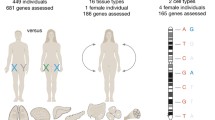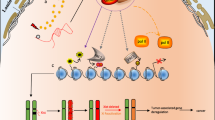Abstract
We report the mRNA and protein expression levels of human biglycan (BGN) in patients with different numbers of sex chromosomes. BGN maps to the distal long arm of the X chromosome, band Xq28, near the second pseudoautosomal region. BGN expression levels are reduced in 45,X Turner patients and increased in patients with additional sex chromosomes. This is suggestive of a pseudoautosomal gene or a gene that escapes X inactivation and that has an active Y chromosomal copy. However, we also provide evidence from hybrid cell lines that BGN is subject to X inactivation and that there is no homolog on the Y chromosome. This evidence excludes an escape from X inactivation. Moreover, additional Y chromosomes increase BGN expression levels, despite the absence of a Y chromosomal BGN gene. Therefore, another explanation has to be invoked. The “pseudoautosomal expression” of BGN may be attributed to a gene or genes that escape X inactivation and that regulate the transcriptional activity of BGN. This is the first report concerning an X chromosomal gene that does not show the conventional correlation between gene dosage and expression rate known from other X chromosomal genes.
Similar content being viewed by others
References
Agulnik AI, Mitchell MJ, Mattei M-G, Borsani G, Avner PA, Lerner JL, Bishop CE (1994) A novel X gene with a widely transcribed Y-linked homologue escapes X-inactivation in mouse and human. Hum Mol Genet 3:879–884
Ausubel FM, Brent R, Kingston RE, Moore DD, Seidman JG, Smith JA, Struhl K (1992) Current protocols in molecular biology, vol 1. Wiley, New York, pp 4.2.1–4.2.3
Ballabio A, Willard HF (1992) Mammalian X-chromosome inactivation and the XIST gene. Curr Opin Genet Dev 2:439–447
Beresford JN, Fedarko NS, Fisher LW, Midura RJ, Yanagishita M, Termine JD, Robey PG (1987) Analysis of the proteoglycans synthesized by human cells in vitro. J Biol Chem 262:17164–17172
Bianco P, Fisher LW, Young MF, Termine JD, Robey PG (1990) Expression and localization of the two small proteoglycans biglycan and decorin in developing human skeletal and nonskeletal tissues. J Histochem Cytochem 38:1549–1563
Brown CJ, Ballabio A, Rupert JL, Lafreniere RG, Grompe M, Tonlorenzi R, Willard HF (1991) A gene from the region of the human X inactivation centre is expressed exclusively from the inactive X chromosome. Nature 349:38–44
Chandley AC, Goetz P, Hargreave TB, Joseph AM, Speed RM (1984) On the nature and extent of XY pairing at meiotic prophase in man. Cytogenet Cell Genet 38:241–247
Del Castillo I, Cohen-Salmon M, Blanchard S, Lutfalla G, Petit C (1992) Structure of the X-linked Kallmann syndrome gene and its homologous pseudogene on the Y chromosome. Nature Genet 2:305–310
Ellis N, Goodfellow PN (1989) The mammalian pseudoautosomal region. Trends Genet 5:406–410
Fedarko NS, Termine JD, Young MF, Robey PG (1990) Temporal regulation of hyaluronan and proteoglycan metabolism by human bone cells in vitro. J Biol Chem 265:12200–12209
Ferguson-Smith MA (1965) Karyotype-phenotype correlations in gonadal dysgenesis and their bearing on the pathogenesis of malformations. J Med Genet 2:142–155
Fisher LW, Termine JD, Young MF (1989) Deduced protein sequence of bone small proteoglycan I (Biglycan) shows homology with proteoglycan II (Decorin) and several nonconnective tissue proteins in a variety of species. J Biol Chem 264:4571–4576
Fisher LW, Heegard AM, Vetter U, Vogel W, Just W, Termine JD, Young MF (1991) Human biglycan gene: putative promoter, intron-exon junctions, and chromosomal localization. J Biol Chem 266:14371–14377
Fisher EMC, Beer-Romero P, Brown LG, Ridley A, McNeil JA, Bentley Lawrence J, Willard HF, Bieber FR, Page DC (1990) Homologous ribosomal protein genes on the human X and Y chromosomes: escape from X inactivation and possible implications for Turner syndrome. Cell 63:1205–1218
Freije D, Helms C, Watson MS, Donis-Keller H (1992) Identification of a second pseudoautosomal region near the Xq and Yq telomeres. Science 258:1784–1787
Geerkens C, Just W, Vogel W (1994) Deletions of Xq and growth deficit: a review. Am J Med Genet 50:105–113
Graves JAM, Schmidt MM (1992) Mammalian sex chromosomes: design or accident? Curr Opin Genet Dev 2:890–901
Kvaloy K, Galvagni F, Brown WRA (1994) The sequence organization of the long arm pseudoautosomal region of the human sex chromosomes. Hum Mol Genet 5:771–778
Lee GR, MacDiarmid WD, Cartwright GE, Wintrobe MM (1968) Hereditary, X-linked, sideroachrestic anemia: the isolation of two erythrocyte populations differing in XgA blood type and porphyrin content. Blood 32:59–70
Lyon MF (1988) The William Allan Memorial Award Address: X-Chromosome inactivation and the location and expression of X-linked genes. Am J Med Genet 42:8–16
Mann J, Cahan A, Gelb AG, Fisher N, Hamper J, Tippet P, Sanger R, Race RR (1962) A sex-linked blood group. Lancet I:8–10
Ogata T, Matsuo N (1993) Sex chromosome aberrations and stature: deduction of the principal factors involved in the determination of adult height. Hum Genet 91:551–562
Ohno S (1967) Sex chromosomes and sex-linked genes. Springer, Berlin Heidelberg New York
Page DC, Mosher R, Simpson EM, Fisher EMC, Mardon G, Pollack J, McGillivray B, Chapelle A de la, Brown LG (1987) The sex-determining region of the human X chromosome encodes a finger protein. Cell 51:1091–1104
Peterkofsky D, Diegelmann R (1971) Use of a mixture of proteinase free collagenases for the specific assay of radioactive collagen in the presence of other proteins. Biochemistry 10:988–1005
Piechaczyk M, Blanchard JM, Marty L, Dani C, Panabieres F El Sabouty S, Fort P, Jaenteur P (1984) Post-transcriptional regulation of glyceraldehyde-3-phosphate dehydrogenease gene expression in rat tissues. Nucleic Acids Res 12:6951–6963
Rappold GA (1993) The pseudoautosomal regions of the human sex chromosomes. Hum Genet 92:315–324
Riggs AD, Pfeifer GP (1992) X-chromosome inactivation and cell memory. Trends Genet 8:169–174
Sambrook J, Fritsch EF, Maniatis T (1989) Molecular cloning: a laboratory manual. Cold Spring Harbor Laboratory, Cold Spring Harbor, NY
Schiebel K, Weiss B, Wöhrle D, Rappold G (1993) A human pseudoautosomal gene, ADP/ATP translocase, escapes X-inactivation whereas a homologue on Xq is subject toX-inactivation. Nature Genet 3:82–87
Schneider-Gädicke A, Beer-Romero P, Brown LG, Nussbaum R, Page DC (1989) ZFX has a gene structure similar to ZFY, the putative human sex determinant, and escapes X inactivation. Cell 57:1247–1258
Singer-Sam J, Robinson MO, Bellvé AR, Simon MI, Riggs AD (1990) Measurement by quantitative PCR of changes in HPRT, PGK-1, PGK-2, APRT, Mtase, and Zfy gene transcripts during mouse spermatogenesis. Nucleic Acids Res 18:1255–1259
Spencer JA, Sinclair AH, Watson JM, Graves JAM (1991) Genes on the short arm of the human X chromosome are not shared with the marsupial X. Genomics 11:339–345
Traupe H, Van den Ouweland AMW, Van Oost BA, Vogel W, Vetter U, Warren ST, Rocchi M, Darlison MG, Ropers H-H (1992) Fine mapping of the human biglycan (BGN) gene within the Xq28 region employing a hybrid cell panel. Genomics 13:481–483
Yen PH, Marsh B, Allen E, Tsai SP, Ellison J, Connolly L, Neiswanger K, Shapiro LJ (1988) The human X-linked steroid sulfatase gene and Y-encoded pseudogene: evidence for an inversion of the Y-chromosome during primate evolution. Cell 55:1123–1135
Yen PH, Ellison J, Salido EC, Mohandas T, Shapiro L (1992) Isolation of a new gene from the distal short arm of the human X chromosome that escapes X-inactivation. Hum Mol Genet 1:47–52
Vetter U, Vogel W, Just W, Young MF, Fisher LW (1993) Human decorin gene: intron-exon junctions and chromosomal localization. Genomics 15:161–168
Watanabe M, Zinn AR, Page DC, Nishimito T (1993) Functional equivalence of human X- and Y-encoded isoforms of ribosomal protein S4 consistent with a role in Turner syndrome. Nature Genet 4:268–271
Wöhrle D, Fryns J-P, Steinbach P (1990) Fragile X expression and X inactivation. Hum Genet 85:659–665
Wu J, Ellison J, Salido E, Yen P, Mohandas T, Shapiro LJ (1994) Isolation and characterization of XE169, a novel human gene that escapes X-inactivation. Hum Mol Genet 3:153–160
Author information
Authors and Affiliations
Rights and permissions
About this article
Cite this article
Geerkens, C., Vetter, U., Just, W. et al. The X-chromosomal human biglycan gene BGN is subject to X inactivation but is transcribed like an X-Y homologous gene. Hum Genet 96, 44–52 (1995). https://doi.org/10.1007/BF00214185
Received:
Revised:
Issue Date:
DOI: https://doi.org/10.1007/BF00214185




